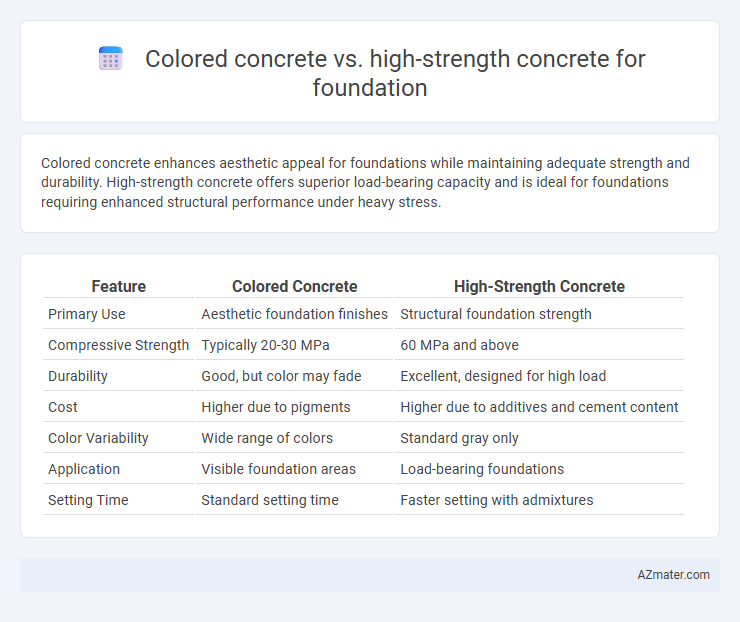Colored concrete enhances aesthetic appeal for foundations while maintaining adequate strength and durability. High-strength concrete offers superior load-bearing capacity and is ideal for foundations requiring enhanced structural performance under heavy stress.
Table of Comparison
| Feature | Colored Concrete | High-Strength Concrete |
|---|---|---|
| Primary Use | Aesthetic foundation finishes | Structural foundation strength |
| Compressive Strength | Typically 20-30 MPa | 60 MPa and above |
| Durability | Good, but color may fade | Excellent, designed for high load |
| Cost | Higher due to pigments | Higher due to additives and cement content |
| Color Variability | Wide range of colors | Standard gray only |
| Application | Visible foundation areas | Load-bearing foundations |
| Setting Time | Standard setting time | Faster setting with admixtures |
Introduction to Colored and High-Strength Concrete Foundations
Colored concrete foundations enhance aesthetic appeal and customization options by incorporating pigments into the mix, making them ideal for visually distinct projects. High-strength concrete foundations offer superior durability and structural support, typically achieving compressive strengths above 6,000 psi, which is crucial for heavy load-bearing applications. Both types serve different functional and design purposes, with colored concrete focusing on appearance and high-strength concrete prioritizing performance.
Key Differences Between Colored and High-Strength Concrete
Colored concrete integrates pigments to achieve aesthetic appeal without significantly altering its structural properties, making it ideal for decorative foundations. High-strength concrete emphasizes enhanced compressive strength, typically exceeding 6000 psi, designed to support heavy loads and improve durability in foundation applications. The key difference lies in their primary function: colored concrete prioritizes visual customization, while high-strength concrete focuses on mechanical performance and longevity.
Composition and Manufacturing Process
Colored concrete incorporates pigments such as iron oxide or titanium dioxide into the cement mixture, with a standard composition of cement, aggregates, water, and color additives, maintaining usual strength parameters. High-strength concrete is made by optimizing the water-to-cement ratio, increasing cement content, and including supplementary materials like silica fume or fly ash to enhance compressive strength beyond 6,000 psi. The manufacturing process of colored concrete focuses on uniform pigment dispersion during mixing, while high-strength concrete requires precise batching, high-quality materials, and often steam curing to achieve optimal durability and load-bearing capacity for foundations.
Strength and Durability Comparison
High-strength concrete typically achieves compressive strengths above 6,000 psi, providing superior load-bearing capacity and improved resistance to cracking compared to colored concrete, which generally has standard strength levels around 3,000 to 5,000 psi. The durability of high-strength concrete surpasses that of colored concrete due to its lower permeability, enhanced resistance to freeze-thaw cycles, and better chemical resistance, making it more suitable for foundation applications exposed to harsh environments. Colored concrete, while offering aesthetic appeal with pigmentation, may require additional sealants to achieve similar durability, especially in structural foundations demanding long-term performance.
Aesthetic Considerations for Foundations
Colored concrete for foundations offers enhanced aesthetic appeal through customizable hues and tones, allowing architects to integrate visually striking designs directly within the structure. High-strength concrete prioritizes structural integrity and durability but typically features a uniform gray appearance, limiting aesthetic flexibility. Choosing colored concrete supports creative architectural expressions, while high-strength concrete ensures long-lasting foundation performance without cosmetic variation.
Cost Analysis: Colored vs High-Strength Concrete
Colored concrete typically incurs higher initial costs due to pigments and specialized mixing processes, whereas high-strength concrete involves added expenses from advanced admixtures and higher cement content to achieve greater compressive strength. The lifecycle cost for colored concrete might increase if aesthetic maintenance is required, while high-strength concrete often reduces long-term costs by minimizing foundation repair and increasing durability. Evaluating total expenditure requires balancing upfront material and labor costs against potential savings from durability and reduced maintenance.
Installation Techniques and Requirements
Colored concrete for foundations requires careful pigment integration during mixing to ensure uniform color distribution and often involves additional curing time to prevent discoloration, while high-strength concrete demands precise water-cement ratio control and the use of admixtures to achieve the desired compressive strength exceeding 6,000 psi. Installation of colored concrete typically involves handling pigment consistency and surface finishing to enhance aesthetic appeal, whereas high-strength concrete installation prioritizes proper vibration techniques and formwork support to accommodate its lower workability and higher setting temperatures. Both types necessitate specialized curing practices; colored concrete benefits from moisture control to avoid color fading, while high-strength concrete requires extended curing periods under controlled temperature and humidity to maximize strength development.
Maintenance and Longevity Factors
Colored concrete enhances aesthetic appeal with minimal impact on maintenance requirements, often requiring routine sealing to preserve pigmentation and prevent surface wear. High-strength concrete offers superior durability and resistance to structural stress, reducing long-term repair needs and extending foundation lifespan significantly. Maintenance costs remain lower for high-strength concrete due to its enhanced crack resistance and reduced permeability compared to colored concrete.
Environmental Impact and Sustainability
Colored concrete incorporates pigments without significantly altering its environmental footprint, making it a sustainable choice when combined with recycled aggregates or supplementary cementitious materials. High-strength concrete minimizes the required volume of material due to its enhanced load-bearing capacity, reducing cement consumption and associated CO2 emissions during foundation construction. Evaluating both options, colored concrete excels in aesthetic sustainability, while high-strength concrete offers superior environmental benefits through material efficiency and reduced carbon footprint.
Choosing the Right Concrete Type for Your Foundation
Colored concrete offers aesthetic versatility for visible foundation elements but typically maintains standard strength levels, making it suitable for decorative finishes rather than load-bearing requirements. High-strength concrete, characterized by compressive strengths exceeding 6,000 psi, provides enhanced durability and is ideal for foundations subjected to heavy loads or challenging soil conditions. Selecting the appropriate concrete type depends on structural demands, exposure conditions, and design preferences to ensure foundation performance and longevity.

Infographic: Colored concrete vs High-strength concrete for Foundation
 azmater.com
azmater.com